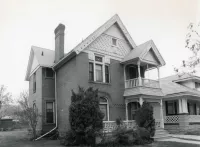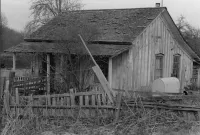Share what you know,
and discover more.
Share what you know,
and discover more.
Oct 13, 1983

-

- Charmaine Bantugan
National Register of Historic Places - Allsop-Jensen House
Statement of Significant: The Mabry-Van Pelt House, built in 1891, is architecturally and historically significant as one of the ten remaining houses that were original to Perkins « Addition subdivision, the most visually cohesive example o f a streetcar subdivision in Salt Lake City. Streetcar subdivision played a major role in the transformation of the land south of the original city from agricultural to residential use in the 1890s, and Perkins' Addition was considered the standard of subdivision excellence. The Mabry-Van Pelt House, as one of seven houses in Perkins' Addition which are variants of one house pattern, documents a significant process in suburban development-the use of standardized plans that could be varied to accommodate individual preferences. Additionally, this house pattern, distinguished by its gable facade aid double porch entry, is unique in Salt Lake City, having originated in Colorado. This house is also significant for its association with Henry V. Van Pelt, an attorney v4io was prominent in legal and educational affairs in Salt Lake City and Utah serving for eleven years as commissioner of the U.S. District Court in Utah, as a member of the Salt Iake City Board of Education and a trustee and treasurer of Westminster College for many years.
National Register of Historic Places - Allsop-Jensen House
Statement of Significant: The Mabry-Van Pelt House, built in 1891, is architecturally and historically significant as one of the ten remaining houses that were original to Perkins « Addition subdivision, the most visually cohesive example o f a streetcar subdivision in Salt Lake City. Streetcar subdivision played a major role in the transformation of the land south of the original city from agricultural to residential use in the 1890s, and Perkins' Addition was considered the standard of subdivision excellence. The Mabry-Van Pelt House, as one of seven houses in Perkins' Addition which are variants of one house pattern, documents a significant process in suburban development-the use of standardized plans that could be varied to accommodate individual preferences. Additionally, this house pattern, distinguished by its gable facade aid double porch entry, is unique in Salt Lake City, having originated in Colorado. This house is also significant for its association with Henry V. Van Pelt, an attorney v4io was prominent in legal and educational affairs in Salt Lake City and Utah serving for eleven years as commissioner of the U.S. District Court in Utah, as a member of the Salt Iake City Board of Education and a trustee and treasurer of Westminster College for many years.
Oct 13, 1983
National Register of Historic Places - Allsop-Jensen House
Statement of Significant:The Mabry-Van Pelt House, built in 1891, is architecturally and historically significant as one of the ten remaining houses that were original to Perkins « Addition subdivision, the most visually cohesive example o f a streetcar subdivision in Salt Lake City. Streetcar subdivision played a major role in the transformation of the land south of the original city from agricultural to residential use in the 1890s, and Perkins' Addition was considered the standard of subdivision excellence. The Mabry-Van Pelt House, as one of seven houses in Perkins' Addition which are variants of one house pattern, documents a significant process in suburban development-the use of standardized plans that could be varied to accommodate individual preferences. Additionally, this house pattern, distinguished by its gable facade aid double porch entry, is unique in Salt Lake City, having originated in Colorado. This house is also significant for its association with Henry V. Van Pelt, an attorney v4io was prominent in legal and educational affairs in Salt Lake City and Utah serving for eleven years as commissioner of the U.S. District Court in Utah, as a member of the Salt Iake City Board of Education and a trustee and treasurer of Westminster College for many years.
Posted Date
Jun 28, 2023
Historical Record Date
Oct 13, 1983
Source Name
National Register of Historic Places
Source Website
Delete Story
Are you sure you want to delete this story?











